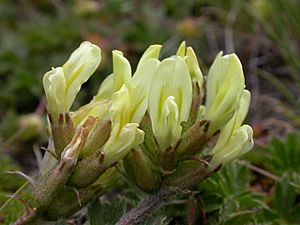Field locoweed facts for kids
Quick facts for kids Field locoweed |
|
|---|---|
 |
|
| Conservation status | |
| Scientific classification | |
| Genus: |
Oxytropis
|
| Species: |
campestris
|
| Synonyms | |
|
Oxytropis gracilis (A. Nelson) K. Schum. |
|
The Field Locoweed (scientific name: Oxytropis campestris) is a type of plant found naturally in the northwestern parts of the United States and all across Canada. Sometimes, people grow it in their gardens because it's pretty.
You can find this plant growing in open grasslands, forests, and meadows. It especially likes rocky or gravelly hillsides, where it grows very well. There are many different kinds, or "variants," of this plant. It's also a food source for the caterpillars of the small blue butterfly.
Contents
What the Field Locoweed Looks Like
The Field Locoweed produces flowers from May to July. These flowers grow in clusters called racemes, which look like spikes of flowers. These clusters can be round or long, usually 4 to 15 centimeters (about 1.5 to 6 inches) long.
Each plant can have 8 to 32 flowers, which grow on a leafless stalk called a scape. The flowers themselves have five parts and form a cup-like structure called a calyx tube. They are usually cream or yellowish, but sometimes they can be pink, blue, or purple. They often have black hairs. The bottom petals, called keel petals, are pointed and sometimes have purple spots.
Fruits and Seeds
After the flowers, the plant grows fruits that ripen from July to September. These fruits are a type of pod called a legume, similar to a pea pod. They are oval-shaped, about 1.5 to 2 centimeters (about 0.6 to 0.8 inches) long.
These pods usually grow directly from the stem without a stalk (this is called sessile). When they are ready, they split open from the tip to release their many seeds (this is called dehiscent). The pods are thin and papery.
Plant Structure
The Field Locoweed is a perennial plant, which means it lives for more than two years. It grows from a deep main root called a taproot. The plant itself doesn't have a main stem above ground (it's acaulescent), but its leaves and flower stalks grow directly from the base. It can reach a height of 20 to 50 centimeters (about 8 to 20 inches).
Its leaves grow in an alternating pattern along the stem and are usually 8 to 40 centimeters (about 3 to 16 inches) long. The plant has two types of leaves (they are dimorphic). The first type has short, oval leaflets. The second type has 11 to 33 smaller leaflets, each about 1 to 2.5 centimeters (about 0.4 to 1 inch) long.
Why Field Locoweed Can Be Dangerous
The Oxytropis campestris plant is poisonous. If farm animals like cattle, horses, or sheep eat too much of it, they can get sick with something called "loco disease." This disease affects their nervous system, making them act strangely, like staggering or having trouble moving.
Because it's poisonous, the Field Locoweed is not good for animals to eat. Animals usually only eat it if there's no other food available. This is why it's often called "field locoweed" or other similar names.
Protecting the Field Locoweed
Even though the Field Locoweed is common in many places, one specific type, called var. chartacea, is quite rare. This rare variety is only found in two counties in the state of Wisconsin in the United States.
Because it's so rare, the United States government has listed it as a threatened species. This means that it's at risk of becoming endangered, and efforts are being made to protect it and its natural habitat.
See also
 In Spanish: Oxytropis campestris para niños
In Spanish: Oxytropis campestris para niños


